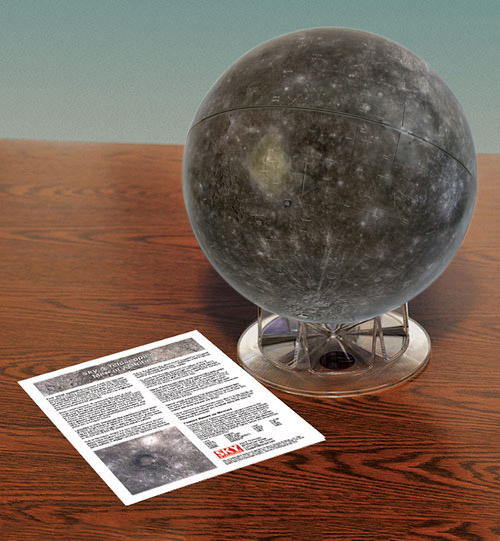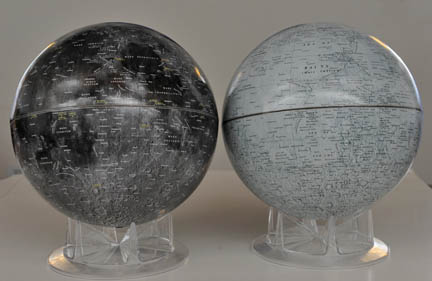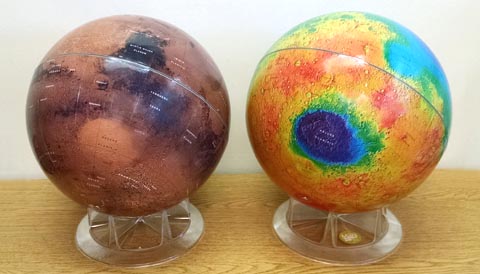Pictures are great, but there's nothing like holding another world in your hands to appreciate its unique characteristics.

S&T: Craig Michael Utter
True confession: even from childhood, I have always been a map junkie. Sure, I use GPS these days, but my car is still stuffed with road maps. The National Geographic Atlas of the World is not far from my desk for fact-checking. I could spend hours (and have) playing with Google Earth.
It's the same with globes. In fact, one of my most prized possessions is a set of NASA globes from the 1970s. The Moon, Mars, and Mercury are accurately scaled to a 12-inch Earth globe, and to accomplish that feat the globes had to be specially crafted as solid wood spheres. Amazing.
So, not surprisingly, over the years I've eagerly spearheaded Sky & Telescope's efforts to develop globes of the Moon and terrestrial planets. We started in the 1980s with Mars, added Venus, and more recently completed the set with the Moon, Mercury, and Earth. For each, we worked with planetary scientists and the astrogeology team at the U.S. Geological Survey in Flagstaff, Arizona. Together with S&T's illustration specialists, most notably Gregg Dinderman, we fretted over colors and lavished attention on every label. We've been fortunate to have found a willing partner in Replogle Globes.
The result is a set of attractive and eye-catching orbs that attract lots of admiring gazes wherever we show them. But they're far more than pretty mini beach balls on the shelf. Honestly, I need to refer to one or more of these globes almost every day at the office. And the more I pore over them, the more I learn. Here's a sample of those insights.

Sky & Telescope
Mercury: Because its surface is nearly gray and heavily cratered, you might initially confuse Mercury for the Moon. But the look is subtly different, due to vast stretches of lava-capped plains. And then there's the crater Hokusai. It's only 95 km (59 miles) across, but its formation created a spectacular splash of bright crater rays that extends more than a quarter of the way around Mercury. No single picture can convey this breadth, but the globe makes it easy.
Venus: Nothing says "cloudy" like Venus. Its atmosphere is so opaque that, except for a few snapshots from the Soviet Union's Venera landers, we have no photographic views of its hellish surface. Fortunately, in the early 1990s NASA's Magellan orbiter used synthetic aperture radar to record the surface details and measure the global topography. Creating a globe of all this data was tricky — the resulting maps portray the radar "brightness" of the surface. But we worked with NASA centers to portray both surface details and elevation in a clear way. Venus is a weird, unique world — its signature geologic features are big, round coronae that are bounded not by high rims but instead deep circular fractures.
Earth: We've all seen globes of Earth that show national boundaries and major cities. For its Earth globe, however, Sky & Telescope's editors wanted to show our home planet the way visiting aliens might see it — crisscrossed by mountains, valleys, and other major geologic structures. We got map data for the land portion from a mosaic of thousands of images, known as the Blue Marble, acquired by NASA's Terra and Aqua satellites. For undersea features, we relied on bathymetry gathered by the British Oceanographic Data Centre. If you're at all interested in plate tectonism — the gradual grinding and collision of Earth's interlocking crustal slabs — this is the globe for you!

Moon: Sky & Telescope contempolated making a Moon globe decades ago but held off until NASA's Lunar Reconnaissance Orbiter delivered the enough detailed mapping to cover the globe consistently. From LRO imagery we made a true-to-the-eye "visual" globe that's quite dark (as the Moon really is). More than 15,000 images went into making the base map! And we used LRO's laser altimetry — 4½ billion individual measurements! — to create a companion topographic Moon globe. (You can get these individually or as a pair.)
A big challenge was determining how many craters and other features to label — the International Astronomical Union has assigned names to more than 9,000 lunar features! We ended up with about 850 labels, including all of the well-known telescopic targets favored by amateur astronomers and the names and landing dates for Apollo, Surveyor, and Luna spacecraft.
One great use of the visual globe is identifying features situated around the limb of the Earth-facing lunar hemisphere. Thanks to the periodic back-and-forth nodding of disk due to libration, some of these marginal objects occasionally come into telescopic view. But they're always seen obliquely, and the globe clearly shows how they really appear. As for the topography globe, the most striking feature — hands-down — is a gigantic impact basin on the far side known as South Pole – Aitken. With a diameter of 2,500 km and a depth of 13 km, it is the largest, deepest, and oldest impact structure on the lunar surface.
Mars: This is the planet that propelled us into the globe business. We've been selling 12-inch replicas of the Red Planet since 1990.

Sky & Telescope
Little-known fact: the Sky & Telescope Mars globe is based on Viking images acquired in the 1970s. So why not use more modern imagery, say, from NASA's Mars Odyssey or Mars Reconnaissance Orbiter? We've explored those, but realistically a 12-inch globe wouldn't do justice to all that finer-resolution detail. (Maybe, someday, we'll make a 6-foot-wide version!) We did tap a more recent spacecraft, Mars Global Surveyor, for the global altimetry to create a color-coded topographic globe of Mars.
If you're a fan of The Martian, either of these globes would be an excellent way to track the progress of astronaut Mark Watney as he tries to survive on — and escape from — the Red Planet. They're also available as a two-globe combo.
Future Offerings
Rest assured: we're not finished with making planet globes! Several new ones are in the works, and we're always looking for ideas. So drop a suggestion (or offer thoughts on S&T globes you already have) in the comment section below.
 3
3
Comments
Robert-Casey
August 28, 2015 at 1:27 pm
When I was a kid in Catholic grammar school, they said we could pray to God and ask for something, and God would make it happen. I wanted a globe of Saturn, but I never did get one. Just like Huck Finn wanted a fishing rod, but he never got one either... 🙂 I did get the Moon globe like the one pictured in the 70's.
You must be logged in to post a comment.
Anthony Barreiro
August 28, 2015 at 3:58 pm
I would love to have a set of globes of the inner planets and the Moon with correct relative sizes. 12-inch diameter Earth and Venus, six-inch diameter Mars, three-inch diameter Mercury and Moon. You wouldn't be able to label many features on Mercury and the Moon, but the set would give a visceral understanding of just how big these worlds are in relation to one another. And the Earth and Moon globes could be used to demonstrate solar and lunar eclipses, although you would need to hold them 30 feet apart.
You must be logged in to post a comment.
Nicole Sharp
August 23, 2022 at 5:42 am
After Luna, Mercury, and Mars, the next largest object in angular size with a visible surface is Ganymede, followed by Callisto. It might be nice to see a set of globes for the Galilean moons. Ceres would be next after Io and Europa.
You must be logged in to post a comment.
You must be logged in to post a comment.